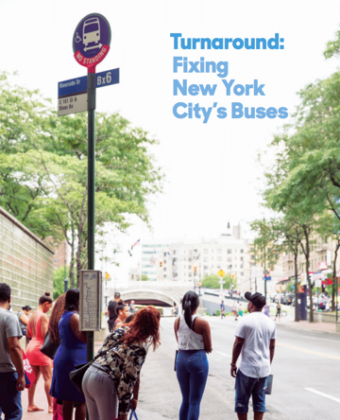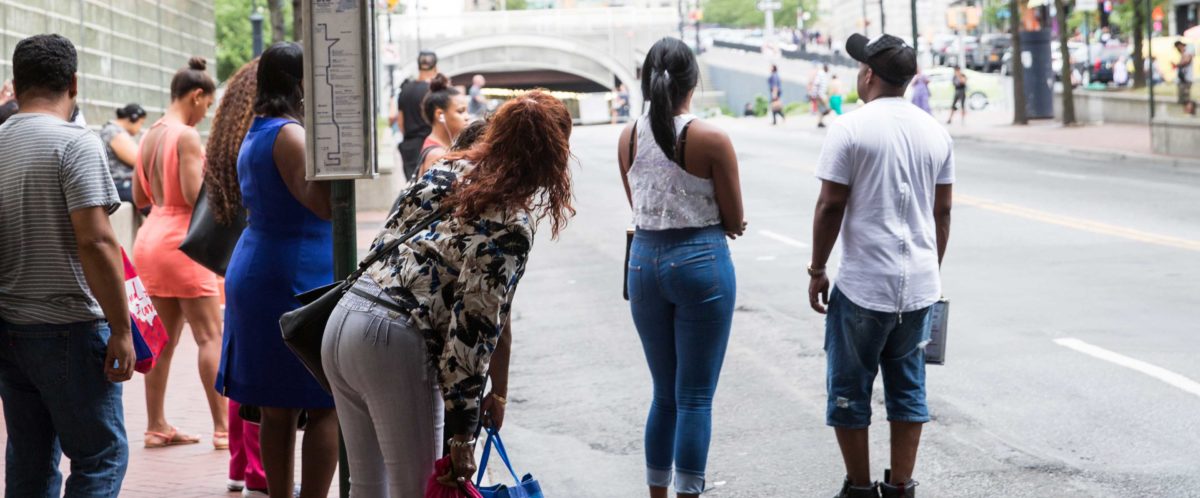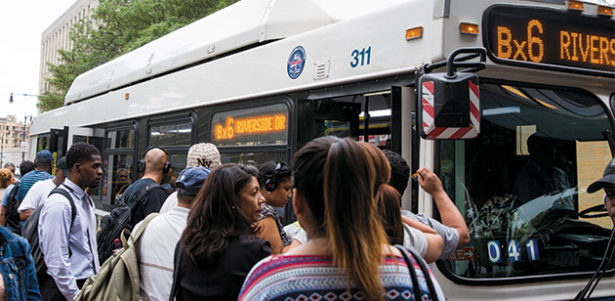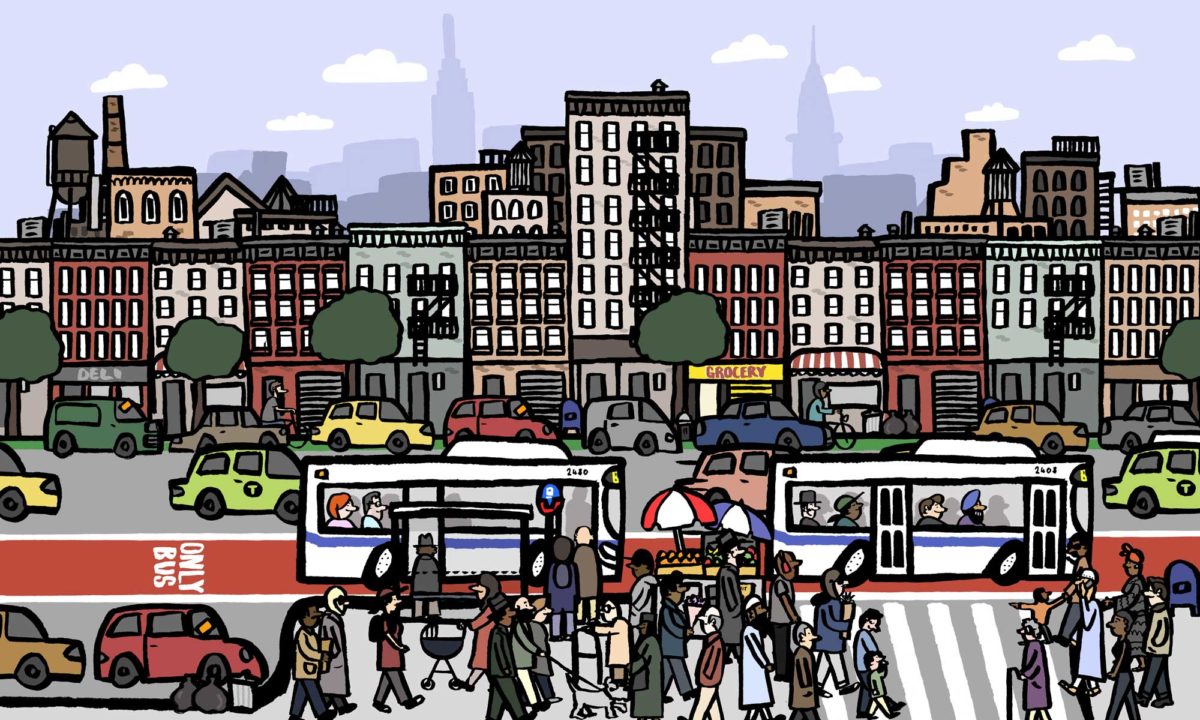Introduction
In a new report, “Turnaround: Fixing New York City’s Buses,” we outline several concrete solutions that can be applied to make New York’s buses work better for riders. These include a top-to-bottom re-examination of the citywide bus network, reforming the boarding process, using better methods to keep buses on schedule, and designing streets to help buses run smoothly.
Complementing the report is BusTurnaround.NYC, which allows visitors to “ride along” with three New York City bus riders. The website also shows you high level report cards for every New York City Transit bus route, and provides the opportunity to ask for better buses from MTA & DOT officials.
New Yorkers deserve buses they can depend on, and “Turnaround” is the first step in a sustained advocacy effort to improve the country’s busiest bus system.
Press
Politico New York: “Advocates seek to rescue a ‘failing’ bus system” , July. 19 2016
New York Daily News: Transit advocates, officials rally in Brooklyn for more reliable bus service, better routes throughout NYC“, July. 20 2016
amNY: Bus Turnaround Campaign launched to save NYC’s buses, a system ‘in crisis‘, July. 20 2016,
Politico New York: As electeds assail bus service, MTA says improvements already underway , July. 20 2016
DNAinfo: New routes and payment system can increase flagging ridership: report, July. 20 2016,
Streetsblog New York: It’s time to think big to turn around lousy bus service in NYC, July. 20 2016,
Human Transit: “‘Subway deserts’ and the bus ‘turnaround’ campaign”, July. 20 2016
Queens Times Ledger: Transit group to release study to reverse bus ridership slump, July. 20 2016
Brooklyn Patch: Advocates and officials outline proposals for citywide bus improvements, July. 20 2016
CBS New York/1010 WINS: NYC officials need to prioritize buses if they want to increase ridership, advocate says, July. 20 2016
WNYC: Riders, ‘voting with their Metrocards,’ are abandoning NYC buses, July. 20 2016
Wall Street Journal: Better bus service sought as ridership drops, July. 20 2016
News 12 Brooklyn: Group wants city bus overhaul; MTA says it’s underway, July. 20 2016
NY1: Transit advocate report notes ways MTA and DOT can improve bus service, July. 20 2016
Epoch Times: “纽约巴士服务差 乘客组织提六大建议” [Chinese], July. 21 2016
Gawker: Why don’t you ride the bus?, July. 21 2016
Slate: The astounding collapse of American bus ridership, July. 21 2016
6sqft: Transportation coalition wants NYC to fix failing bus service, July. 21 2016,
NTDTV: “纽约巴士服务差 乘客组织提建议改善” [Chinese], July. 21 2016
Metro New York: Officials and transit advocates rally for improved NYC bus service, July. 21 2016
Next City: There’s a new plan to fix NYC’s failing bus system, July. 21 2016
Fort Greene Focus: Slower than ‘a herd of lumbering elephants’: new study seeks to improve bus service, July. 21 2016
The New York Times: Why You’re Still Stuck on the Bus, October. 27 2016,
WNYC: Riders, ‘voting with their Metrocards,’ are abandoning NYC buses, July. 20 2016
Recommendations
Fixing the bus system in New York has never been so urgent. If the MTA, the NYCDOT, and the elected officials who represent riders can find the courage to tackle the problem, New York can reverse the bus system’s decline and reclaim its place as a center of transit innovation and leadership, locally and worldwide.
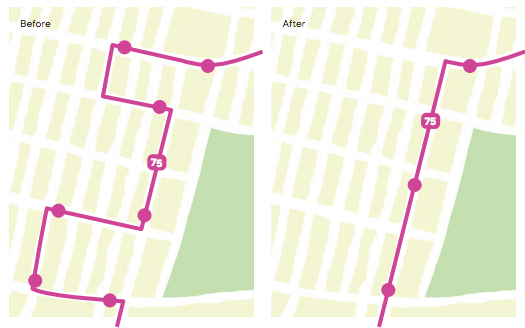
Determine how and where the current bus network is failing and redesign as needed. Bold reconsideration and revision of our bus network is overdue. New routes may be needed. Some existing routes may be obsolete or need substantial adjustment.
Redesign indirect routes. Many of our routes have unnecessary turns and deviations. We should take a fresh look at routes, revising them to take the most direct path between major destinations.
Rightsize the distance between bus stops. New York is a global outlier in terms of how closely stops are spaced, and on many routes, stops are even closer together than our own standards dictate. Optimizing the number of stops will speed trips for riders.
Implement tap-and-go onboard fare collection and all-door boarding to dramatically reduce the time spent at bus stops. As the MTA considers new fare-payment technology, the agency should also consider how it can improve the boarding process so that we’re sure to achieve the maximum gains from this significant investment.
Continue to pursue better bus design to improve movement onto and within our buses. For example, low-floor buses and bus doors that open quickly and easily for entering or exiting passengers can reduce time spent at bus stops.
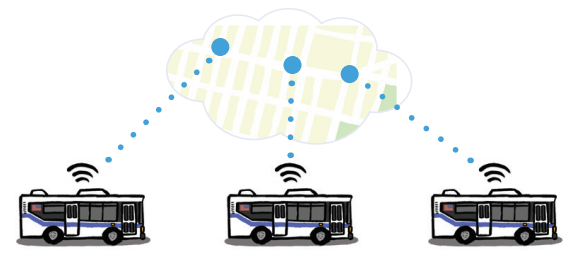
Ensure that buses depart from the terminal on time. Frequent late starts at the beginning of runs make it difficult for buses to provide service at the expected times and with even spacing.
Once buses are on the road, intervene early when they get off track. In cities with the most reliable buses, dispatchers are in constant communication with drivers to modify service and keep buses on schedule. Such intervention is standard practice in New York subways, but not on the city’s buses. MTA New York City Transit’s bus control centers should emphasize reliability and consistency of service in addition to their current role in responding to discrete incidents.
Implement headway-based control for frequent buses to empower dispatchers and drivers to make real-time improvements for riders. For frequent routes, maintaining even spaces between buses is key. Allowing dispatchers to occasionally hold a bus at a stop or instruct another bus to skip a stop improves service for the greatest number of riders.
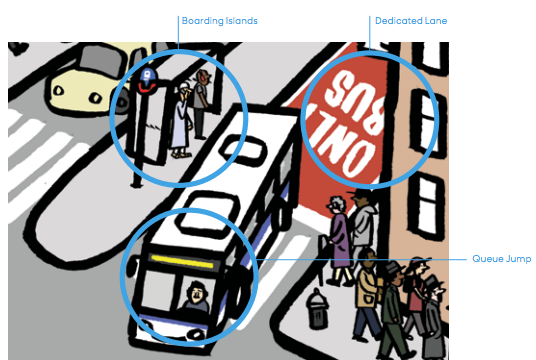
Utilize dedicated lanes to move buses more quickly through crowded streets. Effective enforcement measures such as buslane cameras must ensure the lanes remain clear and violators are fined.
Install bus “bulbs” and boarding islands to eliminate time spent weaving in and out of traffic. These treatments also create dedicated waiting areas for riders, reducing traffic on busy sidewalks and improving pedestrian safety.
Optimize traffic signals to improve reliability by allowing buses to maintain a constant speed and reducing time spent at red lights.
Implement queue-jump lanes to reduce delay by giving buses a short, bus-only lane and a three- or four-second exclusive signal at intersections, allowing them to “jump” ahead of car traffic
